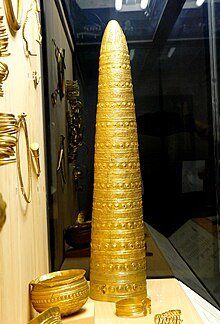The Avanton Gold Cone, Avanton Cone (French: Cône d'Or d'Avanton, Cône d'Avanton), or Avanton gold hat is a late Bronze Age artefact, belonging to the group of Golden hats, only four of which are known so far.
| Avanton Gold Cone | |
|---|---|
 | |
| Material | Gold |
| Height | 55 cm |
| Created | c. 950 BC |
| Discovered | 1844 Nouvelle-Aquitaine, France |
| Present location | Saint-Germain-en-Laye, Ile-de-France, France |
The Avanton Cone was the second such object to be discovered (after the Golden Hat of Schifferstadt). It was found in 1844 in a field near the village of Avanton, about 12 kilometres (7 mi) north of Poitiers, France. The object was damaged; comparison with other finds suggests that a part (the brim) is missing. The remaining part of the Avanton cone is 55-centimetre (22 in) long and weighs 285 grams (10 oz). Originally dated to the Middle Bronze and suggested to be a fertility symbol, it now appears to be of later date and more complex function (see Golden hats).
The Avanton Cone is on display in the Musée d'Archéologie Nationale at Saint-Germain-en-Laye, near Paris.
See also
edit- Golden hats
- Berlin Gold Hat, c. 1,000–800 BC
- Golden Hat of Schifferstadt, c. 1,400–1,300 BC
- Golden Cone of Ezelsdorf-Buch, c. 1,000–800 BC
References
editTourism website referring to the Avanton Cone
- Gold und Kult der Bronzezeit. (AusstellungsKatalog). Germanisches Nationalmuseum, Nürnberg 2003. ISBN 3-926982-95-0
- Wilfried Menghin (ed.): Acta Praehistorica et Archaeologica. Unze, Potsdam 32.2000, S. 31-108. ISSN 0341-1184
- Peter Schauer: Die Goldblechkegel der Bronzezeit – Ein Beitrag zur Kulturverbindung zwischen Orient und Mitteleuropa. Habelt, Bonn 1986. ISBN 3-7749-2238-1